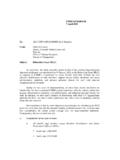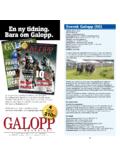Transcription of 2016 Major Automated Information System …
1 2016 Major Automated Information SystemAnnual report Tactical Mission Command (TMC)Defense Acquisition ManagementInformation Retrieval(DAMIR) UNCLASSIFIED TMC2016 MAR UNCLASSIFIED2 Table of Contents Common Acronyms and Abbreviations for MAIS Programs 3 Program Information 4 Responsible Office 4 References 4 Program Description 5 Business Case 6 Program Status 7 Schedule 8 Performance 9 Cost 11 Common Acronyms and Abbreviations for MAIS ProgramsAcq O&M - Acquisition-Related Operations and Maintenance ADM - Acquisition Decision Memorandum AoA - Analysis of Alternatives ATO - Authority To Operate APB - Acquisition Program Baseline BY - Base Year CAE - Component Acquisition Executive CDD - Capability Development Document CPD - Capability Production Document
2 DAE - Defense Acquisition Executive DoD - Department of Defense DoDAF - DoD Architecture Framework FD - Full Deployment FDD - Full Deployment Decision FY - Fiscal Year IA - Information Assurance IATO - Interim Authority to Operate ICD - Initial Capability Document IEA - Information Enterprise Architecture IOC - Initial Operational Capability IP - Internet Protocol IT - Information Technology KPP - Key Performance Parameter $M - Millions of Dollars MAIS - Major Automated Information System MAIS OE - MAIS Original Estimate MAR MAIS annual report MDA - Milestone Decision Authority MDD - Materiel Development Decision MILCON - Military Construction MS - Milestone N/A - Not Applicable O&S - Operating and Support OSD - Office of the Secretary of Defense PB - President s Budget RDT&E - Research, Development, Test, and Evaluation SAE - Service Acquisition Executive TBD - To Be Determined TY - Then Year United States Code USD(AT&L) - Under Secretary of Defense for Acquisition, Technology, & Logistics TMC2016 MAR UNCLASSIFIED3Mr.
3 Robert TischBuilding 6007 Aberdeen Proving Ground, MD Phone:648-1701 DSN Fax:Date Assigned:February 5, 2016 Program InformationProgram Name Tactical Mission Command (TMC)DoD Component ArmyResponsible OfficeProgram Manager ReferencesMAIS Original Estimate December 31, 2007 Approved APB Army Acquisition Executive (AAE) Approved Acquisition Program Baseline (APB) dated August 2, 2013 TMC2016 MAR UNCLASSIFIED4 Program DescriptionTactical Mission Command (TMC) is a family of systems with an enduring mission to provide mission command computing capabilities to Army commanders and their staffs, consisting primarily of a user-customizable Common Operating Picture (COP) enabled with real-time collaboration.
4 These capabilities, together with Voice-Over-Internet-Protocol, combine to provide real-time situational awareness and decision support capabilities across the formation (battalion through Army Service Component Command). A key component of the Mission Command (MC) capability that TMC delivers is the ability to layer Information from multiple warfighting functions on the same map display and share that among command posts, allowing all parties to have a common view with the command. While these capabilities are currently provided by Command Post of the Future (CPOF), TMC is now engaged in transitioning to the web-based Command Post Computing Environment (CPCE).
5 TMC FAMILY OF SYSTEMS Legacy Products: - CPOF has been the Army's primary mission command software System since 2007. CPOF gives commanders and their staffs the ability to enhance operational effectiveness by enabling broad human collaboration and providing a wide array of real-time situational awareness tools in support of decision making, planning, rehearsal, and execution management. - Battle Command Common Services (BCCS) is the heart of interoperability for all MC Systems with the Common Operating Environment. The BCCS architecture is designed for scalability both from a hardware and baseline software architecture perspective, and can be adopted to support various tactical unit standard operating procedures, processes, and integration needs.
6 - Maneuver Control System (MCS) Version as a stand-alone client has reached the end of its service life. It is migrating out of the Army Architecture in accordance with Chief Information Officer G6 direction and will be removed from the MC baseline. - Battle Command Sustainment Support System (BCS3) is being fully divested in second quarter FY 2016. Developmental Products: - TacApps represents the complete porting of all MCS and BCS3 CPD requirements to the web based environment in support of Army objectives. TacApps also aims to minimize administrative burdens on the user and simplify the overall MC collaborative experience.
7 - WAVE is the voice communications solution for TMC products, and also serves as a voice bridging technology allowing disparate voice solutions to communicate seamlessly over the network. WAVE is slated to replace the older Ventrilo technology resident within CPOF. - Command Web Collaborative Data Infrastructure gives the non-provisioned user a web-based COP viewer and data management capability. It is a collaborative, visualization and planning application that also provides a common map display application--a foundational component for all map-centric web applications developed by stakeholders within the CPCE. TMC2016 MAR UNCLASSIFIED5 Business CaseBusiness Case Analysis, including the Analysis of Alternatives (AoA): Key functional requirements for this program were articulated in the MCS Good Enough Operational Requirements Document (ORD) dated March 23, 2004, the current Capabilities Production Document (MCS CPD), and the Joint Requirements Oversight Council (JROC) approval on June 23, 2008, and are summarized as follows.
8 Serves as the TMC System for commanders and staffs from battalion through army service component command and provides essential C2 capability through a collection of maneuver staff tools, collaborative capabilities, and enterprise services. Prior to achieving a planned Milestone III and IOC, a program evaluation and restructure was completed. As part of the program evaluation, the schedule, performance, and costs were reviewed. The AoA considered maintenance of MCS hardware and software; upgrade the existing System with enhancements to security, interoperability, and net-centricity, as well as the development of a new version of software. The AoA resulted in the upgrade of existing systems being approved as the selected alternative on December 16, 2004.
9 As a result, MCS was designated the version in support of the greater ABCS Version An Economic Analysis of the designated version of MCS was later conducted on June 4, 2005. The program progressed from this point and successfully achieved its Milestone C (Full Rate Production Decision) on June 29, 2005, at which time a new acquisition program baseline (APB) was established. The program continues to progress in accordance with the MCS CPD which was approved on June 23, 2008, and the most current APB which was approved on February 28, 2008. In addition, on November 12, 2003, the Army Chief of Staff approved MCS Version as Good Enough to support Milestone C.
10 Firm, Fixed-Price Feasibility: The determination of the development/integration contract type was based on cost and technical risk associated with satisfying the requirement. A new IDIQ contract was awarded to General Dynamics on September 29, 2011 for CPOF Development which will include Cost Plus Fixed Fee, Cost Plus Award Fee and Firm Fixed-Price Task Orders. The Milestone Decision Authority has selected a cost-type contract because development tasks are sufficiently complex and technically challenging that it is impossible to precisely estimate the cost of satisfying the requirements, and it is not practicable to reduce cost and technical risk to a level that would permit the use of a fixed-price contract.












